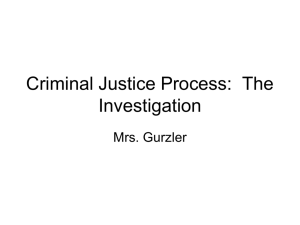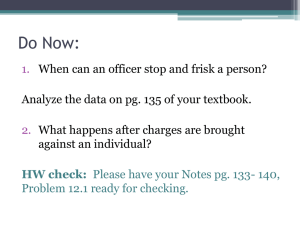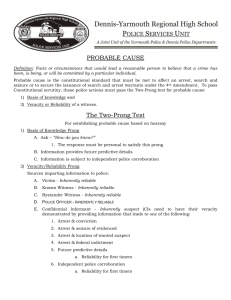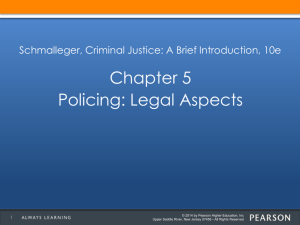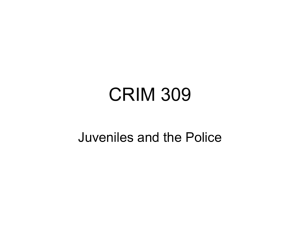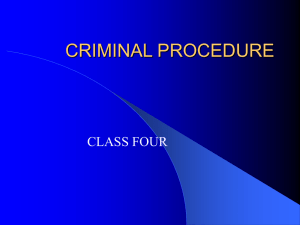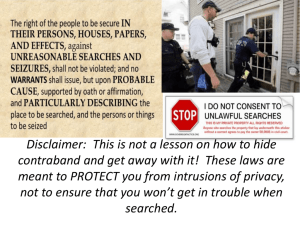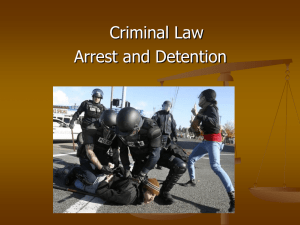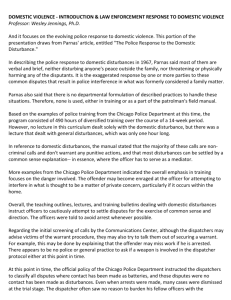Law Chp 12 - McCook Public Schools
advertisement
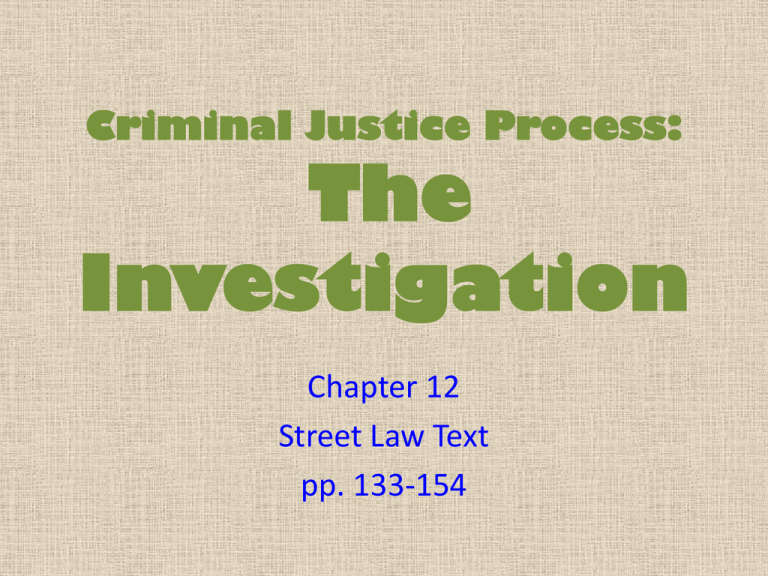
Criminal Justice Process: The Investigation Chapter 12 Street Law Text pp. 133-154 • The Criminal Justice System includes everything that happens to an individual; investigation, arrest, prosecution, conviction, detention, and release • Most crimes are prosecuted under State Law • Typically all cases follow a certain process going from step to step. – After arrest a person could be freed at any step of the process • The Investigation is the important first step! – The investigation, and following steps, must follow the laws and regulations set out by the Constitution and the Courts of the United States Arrest • Arrest- when a person suspected of a crime is taken into custody – An arrest is a seizure under the 4th Amendment – A person that is taken into custody under circumstances in which a reasonable person would not feel free to leave is considered to be under arrest, whether or not he or she is told that • Arrest Warrant- A court order commanding that a person named be taken into custody – A warrant is obtained from a judge [or magistrate] after an officer provides information that a specific person is believed to have committed a crime – Not all Arrests need a warrant, most felonies and misdemeanors can cause immediate arrest if the crime is witnessed by the officer or if the arrest is based on Probable Cause • Probable Cause- Reasonable belief that a specific person has committed a crime – Probable Cause is based on much less evidence than what is needed to convict a person Arrest cont. • Drug Courier Profile- suspected criminal based on typical age, race, personal appearance, behavior, and mannerisms of people trafficking drugs • Police can establish probable cause based on information given to them from the community or informants • Judges will base decisions on warrants or arrests based on many things but may include an informants track record, and corroboration by officers • Corroborate- to confirm, usually by police officers of information given by a “layperson” • Reasonable Suspicion- Evidence that justifies an officer in stopping and questioning a person believed to be involved in a crime [less evidence than Probable Cause] • Stop and Frisk- Pat down, to search person for weapons, is only a quick “pat” through clothing 12.1 The Police receive a tip that a drug pusher named Richie will be flying from New York City to Washington, D.C., sometime the morning of 9/8. The informant describes Richie as a tall man with reddish hair and a beard. He also tells police that Richie has a habit of walking fast and that he will be carrying illegal drugs in a brown leather bag. The police have received reliable information from this informant in the past. On the morning of 9/8, the police watch all passengers arriving from New York. When they see a man who fits the description- carrying a brown leather bag and walking fast, they arrest him. A search of the bag reveals a large quantity of cocaine. a. Do you think the police had probable cause to arrest Richie? Explain b. Should the police have obtained a warrant before arresting Richie? Why or why not? c. Assume the police have not received a specific tip but they know that crack cocaine is being brought regularly on trains from on city to another by teenagers hired by older drug dealers. They see a 16 year old African American male arriving by train. He is alone and is carrying a small canvas bag. Should the police be able to stop and question him? Under what circumstances should they be able to search or arrest him? Search and Seizure • Citizens of the United States expect to have a “right to privacy”, unfortunately there is no explicit “right to privacy” in the Constitution. • There is obviously the 4th Amendment and the freedom from unreasonable searches and seizures, but that is only directed at the “state” not private citizens or companies. • If there is an unwanted violation of privacy by a person or company their may be civil or even criminal action… peeping toms, trespassing, etc. • As for the “state” dealing with searches and seizures there are limits but there are many exceptions to unreasonable searches and seizures. • Exclusionary Rule- Evidence seized in an unlawful manner cannot be used at trial. This does take a motion by the defense attorney to ensure illegally seized evidence is excluded. • Remember illegal searches and seizures only apply to law enforcement, not private citizens. Searches With a Warrant • Search Warrant- Court order to search and seize evidence • Bona Fide- Genuine • Affidavit- Sworn Statement of facts that provides “probable cause” to get a warrant • The affidavit and warrant must be specific to detail the location, items to be searched for, and items to be seized. Any deviation from this will cause the Exclusionary Rule to apply • In almost all cases law enforcement must knock and announce their presence, they are not allowed to do a “no knock” entry into the home using force. Exceptions include anytime evidence can be destroyed before officers search [Drugs] Searches Without a Warrant • Search Incident to a Lawful Arrest – If a person is being arrested their “person” and the immediate area surrounding them • Stop and Frisk – You can be questioned and “patted down” • Consent – If you give permission- ONLY for your OWN property • Border and Airport Searches – Search prior to entering certain areas, “person” & belongings • Vehicle Searches – If there is probable cause after a stop [even containers] • Plain View – If evidence is in “sight” while conducting a lawful search or stop • Hot Pursuit – If chasing a suspect, legal to enter, and evidence is in “sight” • Emergency Situations – Any time there is an “emergency” and through legal entry evidence is found usually in “plain sight” School Searches • The Supreme Court has granted public schools broad powers to search without warrants or even “probable cause”, because of the interest to protect ALL students from dangers [Drugs, alcohol, weapons, bombs] • There are very few limits, but one “interesting” limit is not allowing “strip searches”… I guess in my mind this is like the whole requirement to put “contents may be hot” on a coffee cup… I would hope it was common sense!! Suspicionless Searches • Individual Suspicion is important in almost all situations, but there are some areas that the courts have allowed multiple individuals to be searched without warrants • Police sobriety checks, boarder and airport checks, and even metal detectors are examples of Suspicionless Searches. Racial Profiling in Police Investigations • Racial Profiling- Inappropriate use of race as a factor identifying people who may break or have broken the law • Profiling can take the form of inappropriate police action based on ethnicity, national origin, or religion as well as race. • Example: Searching an “Arab” looking person because of that at an airport • The general rule is that it is inappropriate for an officer to stop a person SOLEY based on his or her race, ethnicity, national origin, or religion. Interrogations and Confessions • Interrogate- Process of questioning the accused person • Many times the interrogation process will result in a confession, sometimes these are coerced though • Self Incrimination- The right from the 5th Amendment to not testify against yourself • The Supreme Court has ruled that a confession is not admissible as evidence if it is NOT voluntary. • Escobedo v. Illinois [64]- If a defendant has asked for an attorney and that request is denied a confession is “excluded” • Miranda Rights: Miranda v. Arizona 1966 court case that required law enforcement to read those arrested their constitutional rights • Custodial Interrogation- A person is in custody, not free to leave, and being interrogated. – Custodial Interrogation is the standard that the court has set for the requirement of Miranda – Just like in the exclusionary rule a defense attorney will ask that any statement made prior to the Miranda warnings be excluded

